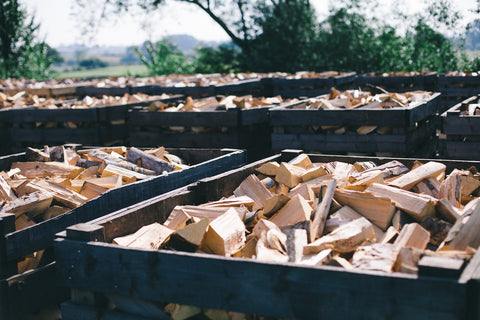Kiln Dried Vs Seasoned Logs – What Is The Difference?
There is a real difference between kiln dried and seasoned logs and the type you choose can affect how well your fire burns. Put simply, kiln dried logs have been dried in a kiln to a consistent low moisture level, while seasoned logs are air-dried over time. Both can be used on your stove or fireplace, but the performance can vary. That's because of the difference in moisture content. Logs with an optimum moisture content of 15%-20 % ignite more easily, burn more efficiently, and produce less smoke.
At Certainly Wood, we’ve spent years helping you get the very best from your wood-burning experience. Here are the key differences to help you choose the right logs for your needs.
Browse our full range of firewood.
What Are Kiln Dried Logs?

At Certainly Wood, our kiln dried firewood has been dried in purpose-built kilns to achieve a low and consistent moisture content of about 15%. The process is more controlled than stacking 'green' logs in a pile and allowing them to dry naturally over a long period of time. After being cut and split, the logs are placed in large chambers called kilns and exposed to heated air circulation.
Browse our range of kiln dried logs.
What Are The Advantages And Disadvantages Of Kiln Dried Logs?

Advantages of kiln dried logs:
- Ready to burn: Kiln dried to a moisture content well below 20% (typically 10–15%), these logs ignite quickly and burn cleanly, perfect for immediate use with no need for further drying.
- Consistent quality: Every log is dried under controlled conditions, guaranteeing uniform quality and performance. You can count on consistent burning behaviour and dependable heat output every time.
- Cleaner burn: Lower moisture means significantly less smoke, soot, and creosote. This helps maintain a clear stove glass and reduces chimney sweep visits.
- Superior heat output: With minimal moisture to evaporate, more of the wood’s energy is converted directly into heat, delivering a warmer, more efficient burn with every fire.
- Pest and Mould Control: The intense heat of the kiln not only dries the wood but also kills off any insects, larvae, or mould spores, ensuring your firewood is clean, safe, and ready for home use or storage.
Disadvantages of kiln dried logs:
- Slightly higher cost: Kiln dried logs may cost a little more than traditionally seasoned logs, but this reflects the added value of their efficiency, cleanliness, and reliability, ultimately saving time and improving performance.
- Must be stored correctly: As with all firewood, to preserve their optimal dryness and performance, kiln dried logs should be stored in a dry, well-ventilated space, something easily managed with a simple log store or covered area.
Learn more about the benefits of kiln dried logs.
What Are Seasoned Logs?

Seasoned logs are left to dry naturally in the open air for an extended period, usually between 12 and 24 months, to reduce their moisture content. This traditional method involves stacking the logs in a well-ventilated, sheltered area where sun and wind can help draw out the moisture. Over time, the logs become drier and more suitable for burning than freshly cut, or “green” wood. However, the drying process depends heavily on weather conditions and storage, so the results can vary. Well-seasoned logs should have a moisture content below 20%, but unless tested, it’s not always easy to know if they’re ready to burn.
What Are The Advantages And Disadvantages Of Seasoned Logs?
Advantages of Seasoned Logs
- Cost-effective: Seasoned logs can be more economical, particularly if you have the time and space to season your own wood. However, achieving the right dryness level can take several years and varies by wood type and weather.
- Availability: These logs can be purchased or prepared at home, offering some versatility, though quality can be inconsistent depending on how well the wood has been dried.
- Eco-friendly: Seasoned using natural air-drying methods, they can be more eco-conscious, but only if dried properly to ensure a clean, efficient burn. Incomplete seasoning can lead to excess smoke and stove residue.
Disadvantages of Seasoned Logs
- Long and Unpredictable Drying Time: Seasoning firewood naturally can take 6–24 months, depending heavily on weather, wood type, and airflow. This makes it an impractical choice for those needing a reliable, year-round supply.
- Inconsistent Moisture Content: Unlike kiln dried logs, which are precision-dried, seasoned logs often retain uneven moisture levels. Logs over 20% moisture won’t burn efficiently, leading to wasted fuel and lower heat output.
- Storage Challenges: Seasoning requires ample, sheltered outdoor space with good ventilation. Without the right conditions, wood may never reach the required dryness and can even start to rot or grow mould.
- Quality Control Issues: Because seasoning is a manual, uncontrolled process, you can't always be sure what you're getting, especially when buying from mixed or uncertified sources.
The main difference between seasoned and kiln dried logs is how they are dried and the final moisture content of your firewood greatly impacts quality and performance. Both seasoned and kiln dried logs can provide an efficient source of heat. Your choice may come down to availability, budget, storage space and how much importance you place on convenience and performance. Read our 'tips on how to choose a firewood supplier' for more helpful advice.

Comments